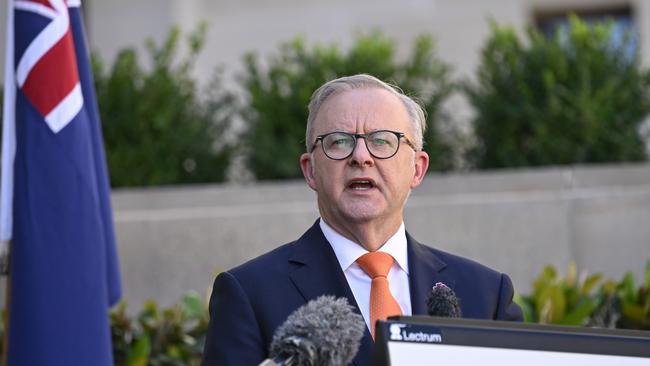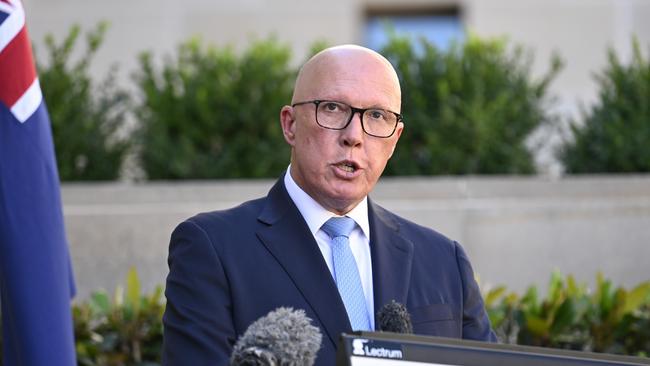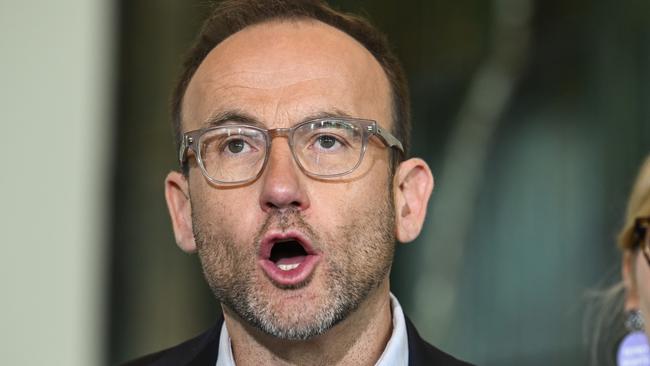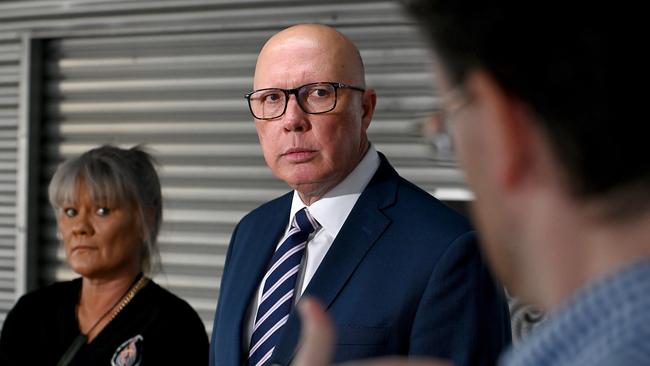Coalition within striking distance of Labor in 20 key marginal seats as RedBridge poll defines voter issues
A new poll, which is an Australian first, has revealed how Peter Dutton is gaining ground but still has a fight on his hands to beat Anthony Albanese. See the results, video and have your say.
Peter Dutton is gaining ground in critical marginal seats and clawing back votes lost to Teals and independents, but it is still not enough to secure him the Lodge in his own right.
The opposition leader’s boost in popularity is being fuelled by voters believing the Coalition would be better than Labor at handling the big three issues impacting everyday Australians - cost of living, housing and healthcare.
Exclusive polling commissioned by this masthead shows the Coalition now leads Labor 52 per cent to 48 per cent on a two-party preferred basis in 20 key marginal seats - representing a 3 per cent swing since the last election.
But it is not enough to secure Mr Dutton an extra 19 seats to reach the 76 he needs to win government outright, reinforcing the prospect of a minority government - which almost half of voters in key electorates agreed would be bad for the economy and people like them.
The findings are taken from a poll which has been commissioned by News Corp Australia.
In an Australian newspaper first, Redbridge and Accent Research will monitor voter shifts between now and election day in 20 marginal seats.
Called a rolling tracking poll, it will mirror the data being used by the major parties to monitor the election.
In a double blow to Prime Minister Anthony Albanese, the results of the first track show only a third of all voters in 20 key seats across Australia think his government has the right priorities, while half of Labor voters say they are still open to changing their vote.
Watch the video above to learn more about the tracking poll.

Overall, voters had a positive view of the Liberal Party with a positive approval rating of +1 whereas the ALP had a negative approval rating of -9.
Neither party’s leader is popular, but Mr Dutton’s approval rating is better than Mr Albanese’s with -16 compared to -13.

Their results were much better than that of Greens Party leader Adam Bandt who had a net negative rating of -23 per cent and of whom a quarter of marginal seat holders said they had never heard.

While only 39 per cent of voters think the Coalition is ready for government, just 31 per cent think Mr Albanese and Labor deserve to be re-elected while a clear majority of 55 per cent believe they do not.
The poll findings suggest Mr Dutton - whose party currently holds 57 seats - is doing slightly better in the marginal seats he needs to win if he is to form government than he is in national polls.

If the 3 per cent two party-preferred swing is replicated across the country, that brings eight seats into play for the Coalition - seven of those held by Labor, and the seat of Ryan in Brisbane, currently held by the Greens.
In the last nationwide Redbridge poll earlier this month, the Coalition led Labor 51.5 per cent to 48.5 per cent.
Redbridge director Kos Samaras said that in a close election like this one nationwide two-party-preferred polls were not the most reliable tool for assessing the political landscape.
“Instead, tracking key seats offers a far more detailed and accurate picture of how parties are performing where it truly matters,” he said.
Cost of living is far and away the most important election issue in marginal seats, with housing and health tied for a distant second place.
But in a major concern for Labor, voters think the government is failing badly on all of them.
The polling found voters have a negative view of Labor’s performance not only on all three of their top electoral concerns but also on crime, the economy, immigration and even climate change and the environment.
In contrast, while the Coalition is rated an overall fail for its handling of all these issues – with the exception of crime and immigration where it rated positively – voters think it has performed better than Labor on all of them except climate change and the environment.
Asked to name the three issues they are most likely to vote on, 44 per cent put cost-of-living first, while 78 per cent overall had it in their top three.
The next two voter issues, housing and health, were rated the top priority by only 7 per cent and 8 per cent of people each, and featured in 31 per cent of people’s concerns.
Dr Shaun Ratcliff of Accent said it was clear that “the issues of this election do not favour Labor”.
He said it’s problem was “it is rated poorly on those matters that the electorate says are most important to deciding their vote.”
But the results for Peter Dutton were not great for Coalition either, he said.
“While the Liberal Party is rated higher on most of the issues that voters say are most important to their vote, it is still rated negatively on more than half – particularly those the electorate cares about the most, like cost of living, housing and healthcare.”
The poll found there are big differences in voting intention between states with Victoria easily the best for the Coalition.
In Mr Albanese’s home state of NSW Labor has a primary vote of 33 per cent in the seats polled, compared to 43 per cent for the Coalition, which translates to a 53 per cent to 47 per cent lead for the conservatives on the two-party-preferred basis.
In contrast Labor’s primary in Victoria is only 31 per cent, while the Liberal vote is a massive 51 per cent – giving the Coalition a marginal seat lead in the state of 58 per cent to 42 per cent.
RedBridge Director Kos Samaras said the results in both these states should be deeply concerning for the ALP.
“Our initial benchmark data suggests that Labor is facing serious challenges in the two key swing states of NSW and Victoria, where trouble appears to be brewing in seats where the cost of living crisis is biting the hardest,” he said.
“That said, this does not immediately translate to a Coalition win and hence, the actual campaign will be critical in determining which major party gets close to 76 seats.”
Surprisingly the Coalition is doing better in both NSW and Victoria than the seats polled in Mr Dutton’s home state of Queensland, where despite a low Labor primary of 29 per cent, the LNP’s first preference share is only 42 per cent.
This translates to a two-party preferred lead of 51 per cent to 49 per cent.
RedBridge director Tony Barry said the Coalition “needed to do better than being seen as less hopeless than Labor on cost of living and housing.”
He said Labor strategists will also be worried, the research shows Peter Dutton’s message that the Liberals have a plan to get Australia back on track was contestable but Albanese’s claim he will build a better Australia is rejected by a majority of voters.
“This shows their meta message isn’t landing with voters so they need to improve the credibility of this positioning statement,” he said.
Older Australians were also more likely to vote for the Coalition while younger people preferred Labor, the poll found.
Originally published as Coalition within striking distance of Labor in 20 key marginal seats as RedBridge poll defines voter issues




